TATA Group of Companies: Corporate Strategy Analysis
VerifiedAdded on 2023/01/20
|22
|5164
|3
Case Study
AI Summary
This case study analyzes the corporate strategy, governance, and ethics of the TATA Group of Companies. The study begins with background information on the TATA Group, a multinational corporation based in India, and provides a critical analysis of the company's operations. It examines the internal environment using SWOT analysis, highlighting strengths such as a strong distribution network and skilled workforce, alongside weaknesses like below-average profitability ratios and gaps in product range. The study also explores opportunities presented by taxation policies and changing customer behavior, as well as threats from competitors and currency fluctuations. Furthermore, the study delves into the TATA Group's organizational culture and its efforts to adapt to customer feedback and identify talent. The external environment is assessed using STEEPLE analysis, considering social, economic, environmental, legal, and other factors impacting the company. The case study also examines TATA's corporate governance practices, emphasizing their commitment to ethical standards, transparency, and stakeholder engagement. It concludes by discussing the competitive landscape and the company's strategies for handling social, ethical, legal, and governance issues.
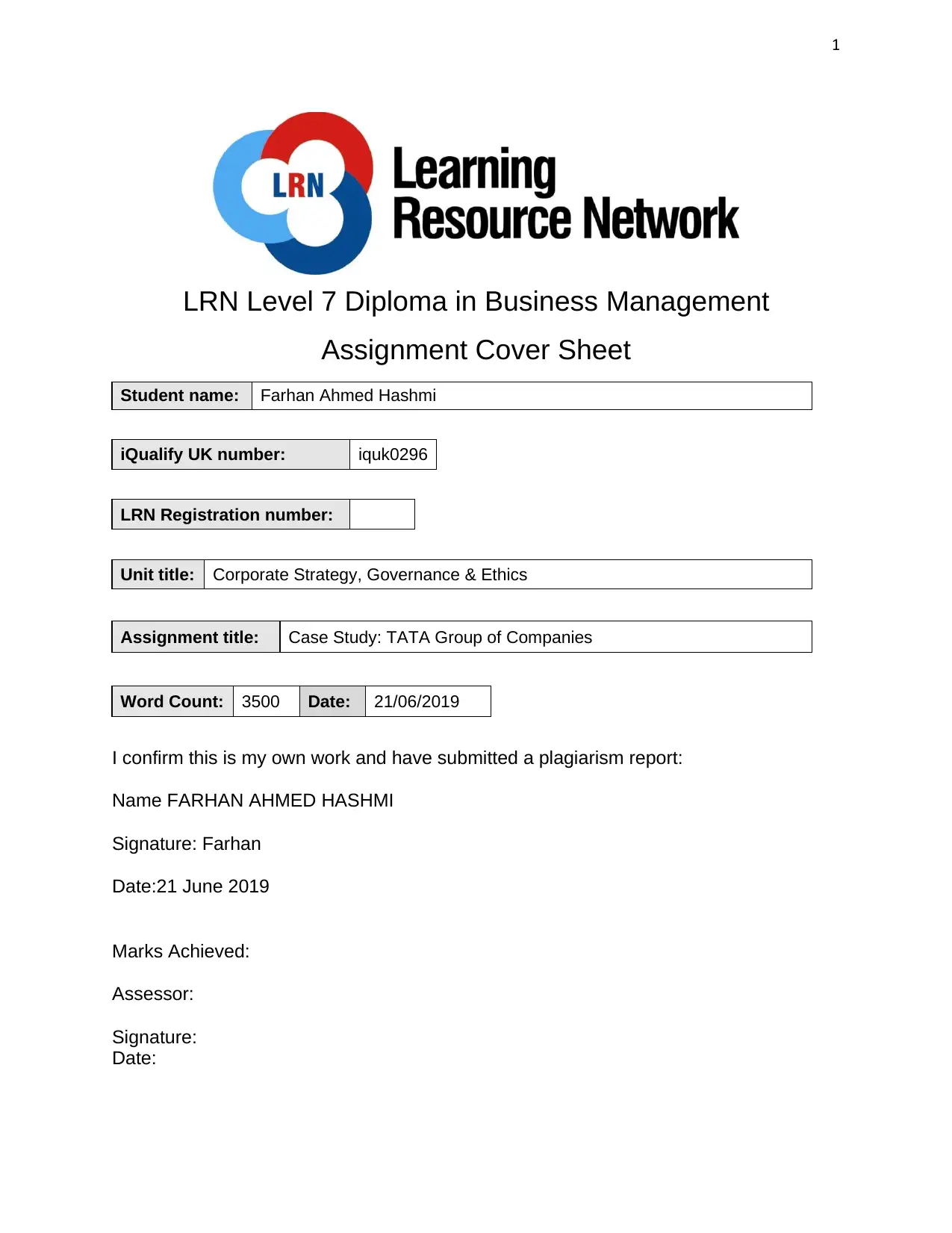
1
LRN Level 7 Diploma in Business Management
Assignment Cover Sheet
Student name: Farhan Ahmed Hashmi
iQualify UK number: iquk0296
LRN Registration number:
Unit title: Corporate Strategy, Governance & Ethics
Assignment title: Case Study: TATA Group of Companies
Word Count: 3500 Date: 21/06/2019
I confirm this is my own work and have submitted a plagiarism report:
Name FARHAN AHMED HASHMI
Signature: Farhan
Date:21 June 2019
Marks Achieved:
Assessor:
Signature:
Date:
LRN Level 7 Diploma in Business Management
Assignment Cover Sheet
Student name: Farhan Ahmed Hashmi
iQualify UK number: iquk0296
LRN Registration number:
Unit title: Corporate Strategy, Governance & Ethics
Assignment title: Case Study: TATA Group of Companies
Word Count: 3500 Date: 21/06/2019
I confirm this is my own work and have submitted a plagiarism report:
Name FARHAN AHMED HASHMI
Signature: Farhan
Date:21 June 2019
Marks Achieved:
Assessor:
Signature:
Date:
Paraphrase This Document
Need a fresh take? Get an instant paraphrase of this document with our AI Paraphraser
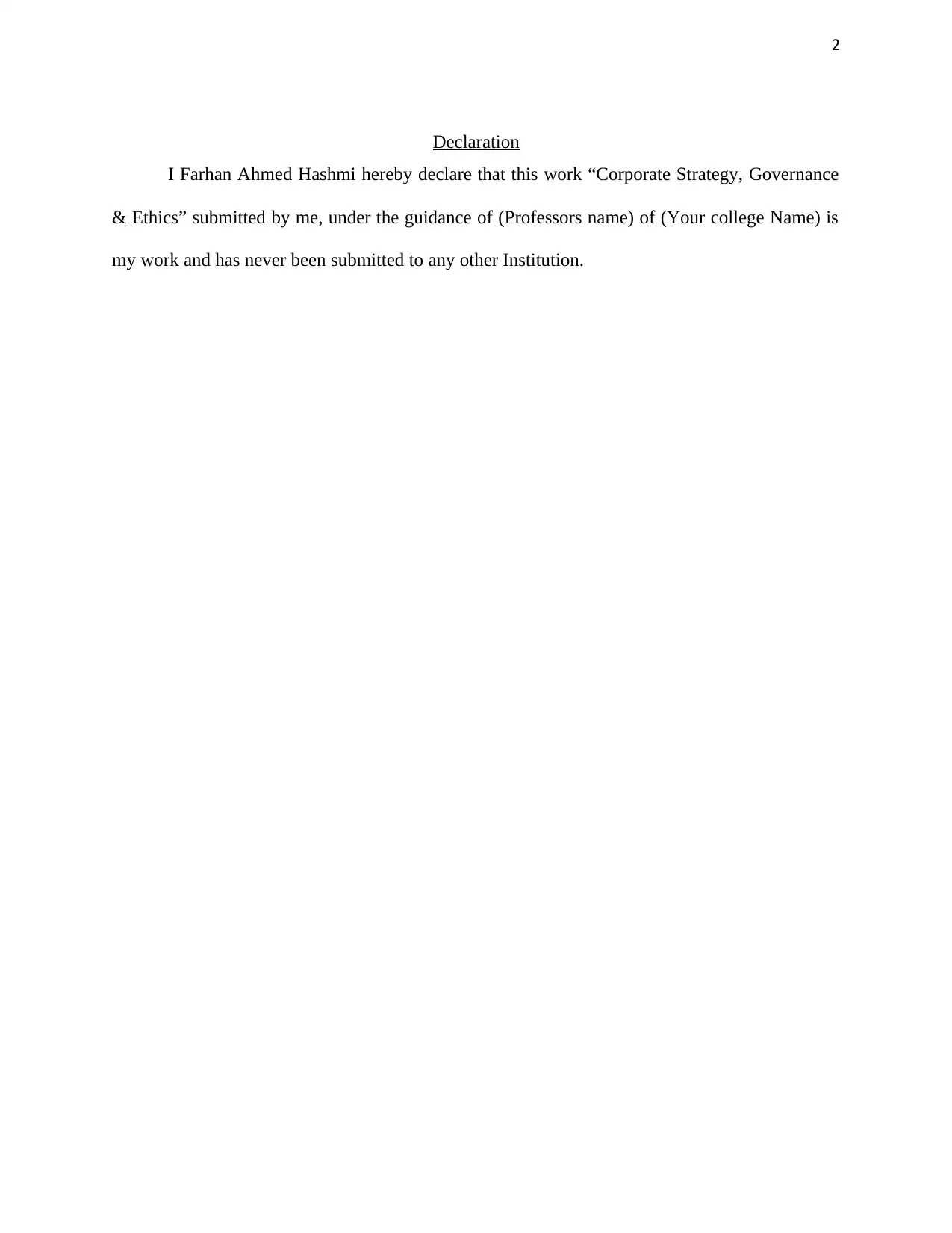
2
Declaration
I Farhan Ahmed Hashmi hereby declare that this work “Corporate Strategy, Governance
& Ethics” submitted by me, under the guidance of (Professors name) of (Your college Name) is
my work and has never been submitted to any other Institution.
Declaration
I Farhan Ahmed Hashmi hereby declare that this work “Corporate Strategy, Governance
& Ethics” submitted by me, under the guidance of (Professors name) of (Your college Name) is
my work and has never been submitted to any other Institution.

3
Table of Content
Table of Content
⊘ This is a preview!⊘
Do you want full access?
Subscribe today to unlock all pages.

Trusted by 1+ million students worldwide
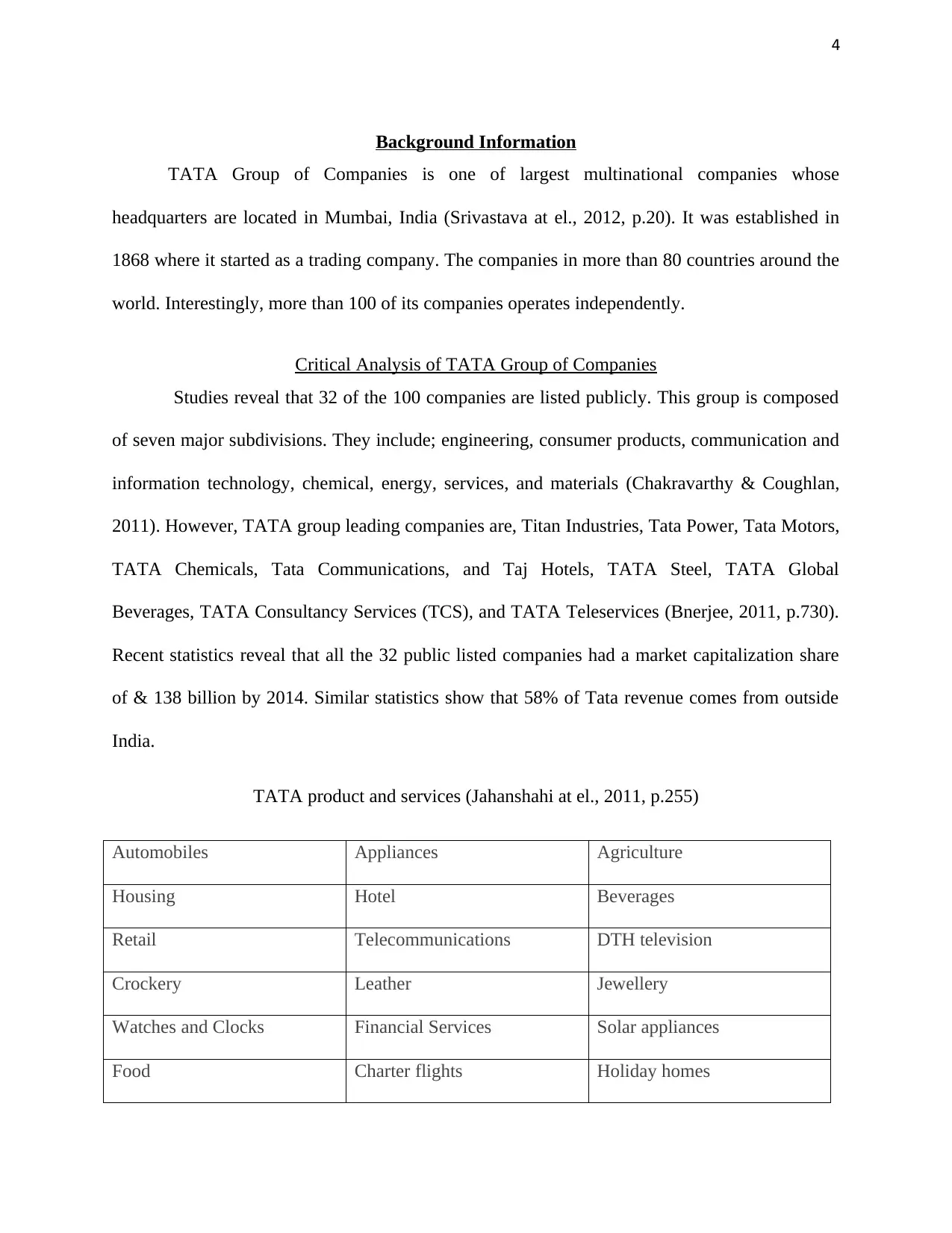
4
Background Information
TATA Group of Companies is one of largest multinational companies whose
headquarters are located in Mumbai, India (Srivastava at el., 2012, p.20). It was established in
1868 where it started as a trading company. The companies in more than 80 countries around the
world. Interestingly, more than 100 of its companies operates independently.
Critical Analysis of TATA Group of Companies
Studies reveal that 32 of the 100 companies are listed publicly. This group is composed
of seven major subdivisions. They include; engineering, consumer products, communication and
information technology, chemical, energy, services, and materials (Chakravarthy & Coughlan,
2011). However, TATA group leading companies are, Titan Industries, Tata Power, Tata Motors,
TATA Chemicals, Tata Communications, and Taj Hotels, TATA Steel, TATA Global
Beverages, TATA Consultancy Services (TCS), and TATA Teleservices (Bnerjee, 2011, p.730).
Recent statistics reveal that all the 32 public listed companies had a market capitalization share
of & 138 billion by 2014. Similar statistics show that 58% of Tata revenue comes from outside
India.
TATA product and services (Jahanshahi at el., 2011, p.255)
Automobiles Appliances Agriculture
Housing Hotel Beverages
Retail Telecommunications DTH television
Crockery Leather Jewellery
Watches and Clocks Financial Services Solar appliances
Food Charter flights Holiday homes
Background Information
TATA Group of Companies is one of largest multinational companies whose
headquarters are located in Mumbai, India (Srivastava at el., 2012, p.20). It was established in
1868 where it started as a trading company. The companies in more than 80 countries around the
world. Interestingly, more than 100 of its companies operates independently.
Critical Analysis of TATA Group of Companies
Studies reveal that 32 of the 100 companies are listed publicly. This group is composed
of seven major subdivisions. They include; engineering, consumer products, communication and
information technology, chemical, energy, services, and materials (Chakravarthy & Coughlan,
2011). However, TATA group leading companies are, Titan Industries, Tata Power, Tata Motors,
TATA Chemicals, Tata Communications, and Taj Hotels, TATA Steel, TATA Global
Beverages, TATA Consultancy Services (TCS), and TATA Teleservices (Bnerjee, 2011, p.730).
Recent statistics reveal that all the 32 public listed companies had a market capitalization share
of & 138 billion by 2014. Similar statistics show that 58% of Tata revenue comes from outside
India.
TATA product and services (Jahanshahi at el., 2011, p.255)
Automobiles Appliances Agriculture
Housing Hotel Beverages
Retail Telecommunications DTH television
Crockery Leather Jewellery
Watches and Clocks Financial Services Solar appliances
Food Charter flights Holiday homes
Paraphrase This Document
Need a fresh take? Get an instant paraphrase of this document with our AI Paraphraser
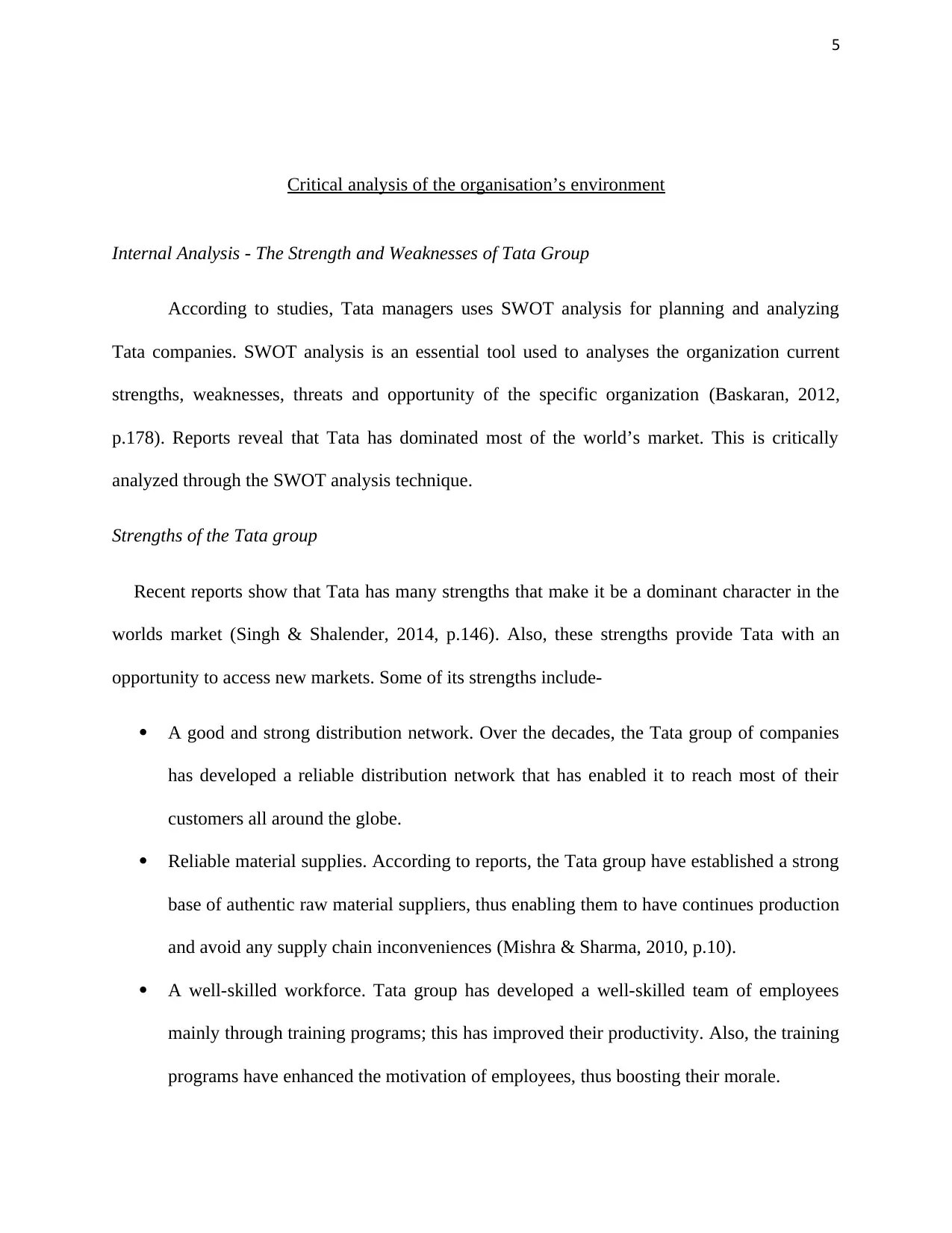
5
Critical analysis of the organisation’s environment
Internal Analysis - The Strength and Weaknesses of Tata Group
According to studies, Tata managers uses SWOT analysis for planning and analyzing
Tata companies. SWOT analysis is an essential tool used to analyses the organization current
strengths, weaknesses, threats and opportunity of the specific organization (Baskaran, 2012,
p.178). Reports reveal that Tata has dominated most of the world’s market. This is critically
analyzed through the SWOT analysis technique.
Strengths of the Tata group
Recent reports show that Tata has many strengths that make it be a dominant character in the
worlds market (Singh & Shalender, 2014, p.146). Also, these strengths provide Tata with an
opportunity to access new markets. Some of its strengths include-
A good and strong distribution network. Over the decades, the Tata group of companies
has developed a reliable distribution network that has enabled it to reach most of their
customers all around the globe.
Reliable material supplies. According to reports, the Tata group have established a strong
base of authentic raw material suppliers, thus enabling them to have continues production
and avoid any supply chain inconveniences (Mishra & Sharma, 2010, p.10).
A well-skilled workforce. Tata group has developed a well-skilled team of employees
mainly through training programs; this has improved their productivity. Also, the training
programs have enhanced the motivation of employees, thus boosting their morale.
Critical analysis of the organisation’s environment
Internal Analysis - The Strength and Weaknesses of Tata Group
According to studies, Tata managers uses SWOT analysis for planning and analyzing
Tata companies. SWOT analysis is an essential tool used to analyses the organization current
strengths, weaknesses, threats and opportunity of the specific organization (Baskaran, 2012,
p.178). Reports reveal that Tata has dominated most of the world’s market. This is critically
analyzed through the SWOT analysis technique.
Strengths of the Tata group
Recent reports show that Tata has many strengths that make it be a dominant character in the
worlds market (Singh & Shalender, 2014, p.146). Also, these strengths provide Tata with an
opportunity to access new markets. Some of its strengths include-
A good and strong distribution network. Over the decades, the Tata group of companies
has developed a reliable distribution network that has enabled it to reach most of their
customers all around the globe.
Reliable material supplies. According to reports, the Tata group have established a strong
base of authentic raw material suppliers, thus enabling them to have continues production
and avoid any supply chain inconveniences (Mishra & Sharma, 2010, p.10).
A well-skilled workforce. Tata group has developed a well-skilled team of employees
mainly through training programs; this has improved their productivity. Also, the training
programs have enhanced the motivation of employees, thus boosting their morale.
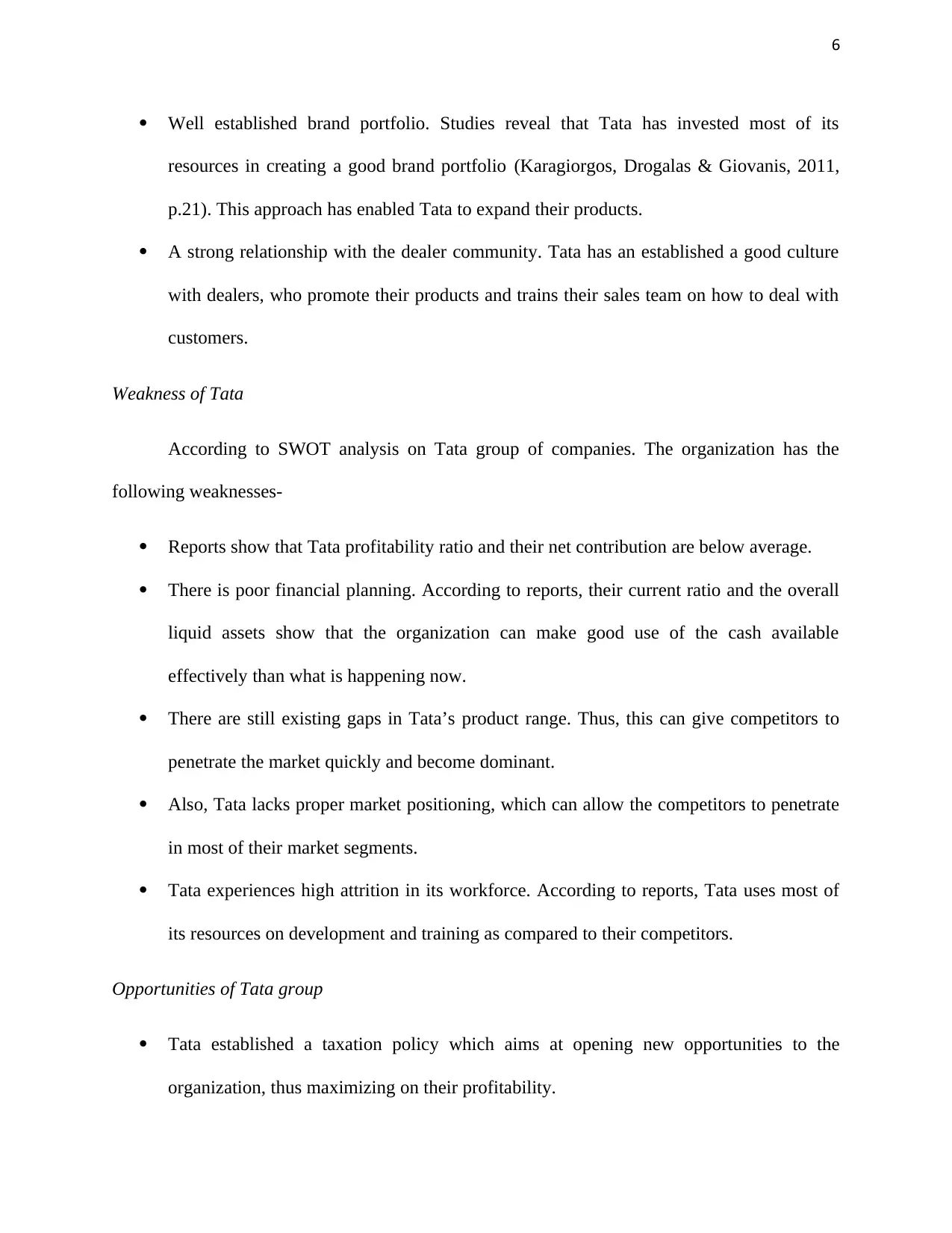
6
Well established brand portfolio. Studies reveal that Tata has invested most of its
resources in creating a good brand portfolio (Karagiorgos, Drogalas & Giovanis, 2011,
p.21). This approach has enabled Tata to expand their products.
A strong relationship with the dealer community. Tata has an established a good culture
with dealers, who promote their products and trains their sales team on how to deal with
customers.
Weakness of Tata
According to SWOT analysis on Tata group of companies. The organization has the
following weaknesses-
Reports show that Tata profitability ratio and their net contribution are below average.
There is poor financial planning. According to reports, their current ratio and the overall
liquid assets show that the organization can make good use of the cash available
effectively than what is happening now.
There are still existing gaps in Tata’s product range. Thus, this can give competitors to
penetrate the market quickly and become dominant.
Also, Tata lacks proper market positioning, which can allow the competitors to penetrate
in most of their market segments.
Tata experiences high attrition in its workforce. According to reports, Tata uses most of
its resources on development and training as compared to their competitors.
Opportunities of Tata group
Tata established a taxation policy which aims at opening new opportunities to the
organization, thus maximizing on their profitability.
Well established brand portfolio. Studies reveal that Tata has invested most of its
resources in creating a good brand portfolio (Karagiorgos, Drogalas & Giovanis, 2011,
p.21). This approach has enabled Tata to expand their products.
A strong relationship with the dealer community. Tata has an established a good culture
with dealers, who promote their products and trains their sales team on how to deal with
customers.
Weakness of Tata
According to SWOT analysis on Tata group of companies. The organization has the
following weaknesses-
Reports show that Tata profitability ratio and their net contribution are below average.
There is poor financial planning. According to reports, their current ratio and the overall
liquid assets show that the organization can make good use of the cash available
effectively than what is happening now.
There are still existing gaps in Tata’s product range. Thus, this can give competitors to
penetrate the market quickly and become dominant.
Also, Tata lacks proper market positioning, which can allow the competitors to penetrate
in most of their market segments.
Tata experiences high attrition in its workforce. According to reports, Tata uses most of
its resources on development and training as compared to their competitors.
Opportunities of Tata group
Tata established a taxation policy which aims at opening new opportunities to the
organization, thus maximizing on their profitability.
⊘ This is a preview!⊘
Do you want full access?
Subscribe today to unlock all pages.

Trusted by 1+ million students worldwide
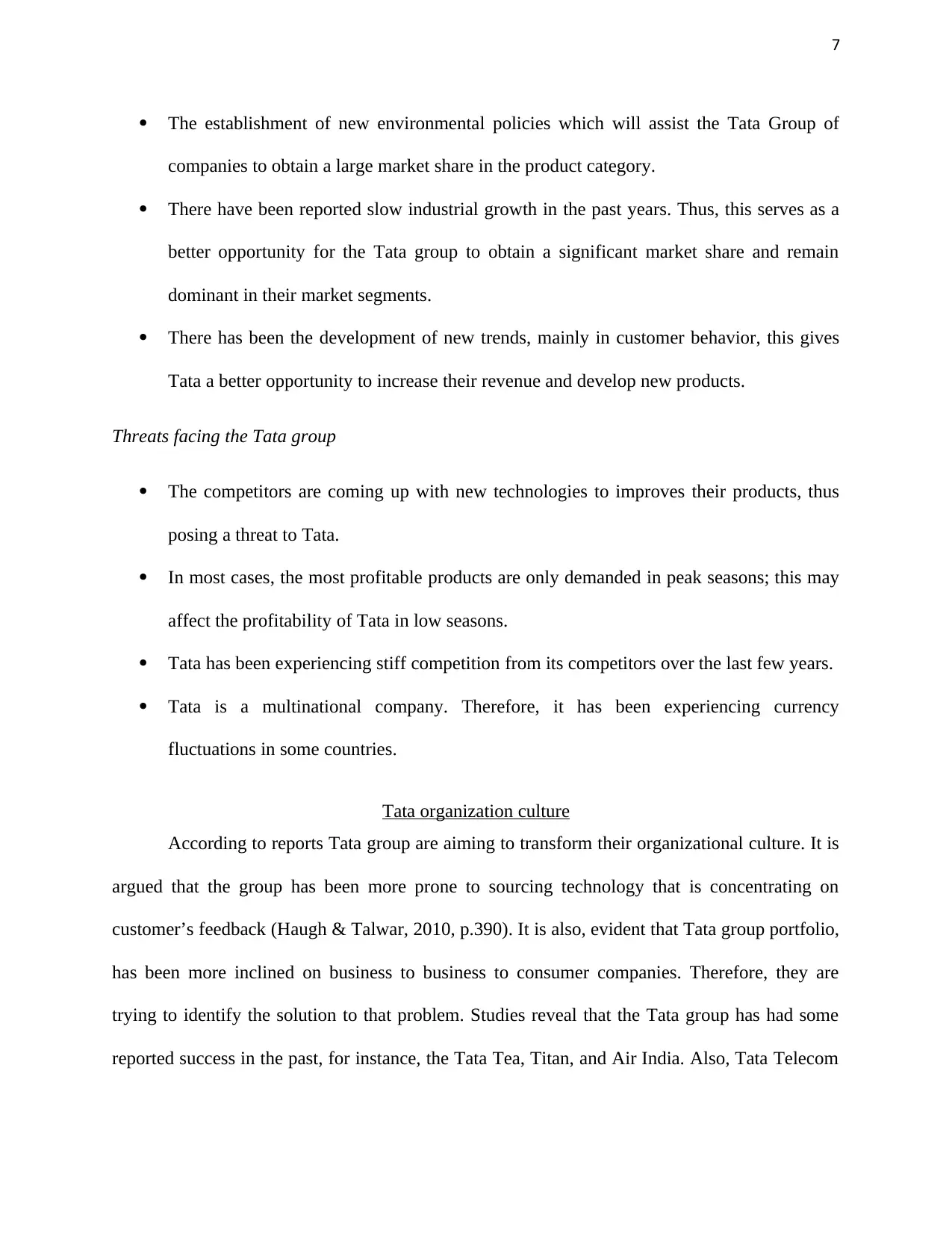
7
The establishment of new environmental policies which will assist the Tata Group of
companies to obtain a large market share in the product category.
There have been reported slow industrial growth in the past years. Thus, this serves as a
better opportunity for the Tata group to obtain a significant market share and remain
dominant in their market segments.
There has been the development of new trends, mainly in customer behavior, this gives
Tata a better opportunity to increase their revenue and develop new products.
Threats facing the Tata group
The competitors are coming up with new technologies to improves their products, thus
posing a threat to Tata.
In most cases, the most profitable products are only demanded in peak seasons; this may
affect the profitability of Tata in low seasons.
Tata has been experiencing stiff competition from its competitors over the last few years.
Tata is a multinational company. Therefore, it has been experiencing currency
fluctuations in some countries.
Tata organization culture
According to reports Tata group are aiming to transform their organizational culture. It is
argued that the group has been more prone to sourcing technology that is concentrating on
customer’s feedback (Haugh & Talwar, 2010, p.390). It is also, evident that Tata group portfolio,
has been more inclined on business to business to consumer companies. Therefore, they are
trying to identify the solution to that problem. Studies reveal that the Tata group has had some
reported success in the past, for instance, the Tata Tea, Titan, and Air India. Also, Tata Telecom
The establishment of new environmental policies which will assist the Tata Group of
companies to obtain a large market share in the product category.
There have been reported slow industrial growth in the past years. Thus, this serves as a
better opportunity for the Tata group to obtain a significant market share and remain
dominant in their market segments.
There has been the development of new trends, mainly in customer behavior, this gives
Tata a better opportunity to increase their revenue and develop new products.
Threats facing the Tata group
The competitors are coming up with new technologies to improves their products, thus
posing a threat to Tata.
In most cases, the most profitable products are only demanded in peak seasons; this may
affect the profitability of Tata in low seasons.
Tata has been experiencing stiff competition from its competitors over the last few years.
Tata is a multinational company. Therefore, it has been experiencing currency
fluctuations in some countries.
Tata organization culture
According to reports Tata group are aiming to transform their organizational culture. It is
argued that the group has been more prone to sourcing technology that is concentrating on
customer’s feedback (Haugh & Talwar, 2010, p.390). It is also, evident that Tata group portfolio,
has been more inclined on business to business to consumer companies. Therefore, they are
trying to identify the solution to that problem. Studies reveal that the Tata group has had some
reported success in the past, for instance, the Tata Tea, Titan, and Air India. Also, Tata Telecom
Paraphrase This Document
Need a fresh take? Get an instant paraphrase of this document with our AI Paraphraser
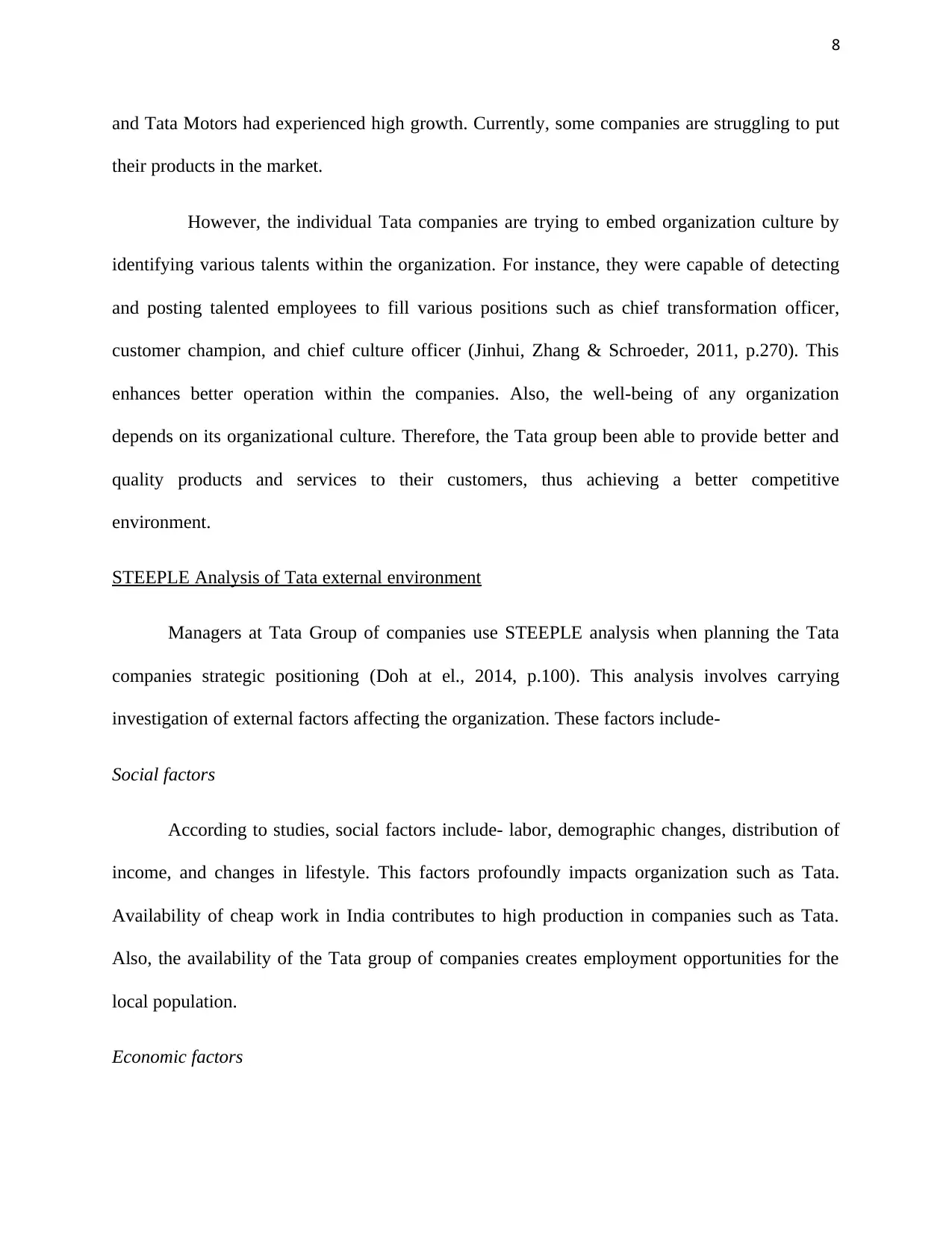
8
and Tata Motors had experienced high growth. Currently, some companies are struggling to put
their products in the market.
However, the individual Tata companies are trying to embed organization culture by
identifying various talents within the organization. For instance, they were capable of detecting
and posting talented employees to fill various positions such as chief transformation officer,
customer champion, and chief culture officer (Jinhui, Zhang & Schroeder, 2011, p.270). This
enhances better operation within the companies. Also, the well-being of any organization
depends on its organizational culture. Therefore, the Tata group been able to provide better and
quality products and services to their customers, thus achieving a better competitive
environment.
STEEPLE Analysis of Tata external environment
Managers at Tata Group of companies use STEEPLE analysis when planning the Tata
companies strategic positioning (Doh at el., 2014, p.100). This analysis involves carrying
investigation of external factors affecting the organization. These factors include-
Social factors
According to studies, social factors include- labor, demographic changes, distribution of
income, and changes in lifestyle. This factors profoundly impacts organization such as Tata.
Availability of cheap work in India contributes to high production in companies such as Tata.
Also, the availability of the Tata group of companies creates employment opportunities for the
local population.
Economic factors
and Tata Motors had experienced high growth. Currently, some companies are struggling to put
their products in the market.
However, the individual Tata companies are trying to embed organization culture by
identifying various talents within the organization. For instance, they were capable of detecting
and posting talented employees to fill various positions such as chief transformation officer,
customer champion, and chief culture officer (Jinhui, Zhang & Schroeder, 2011, p.270). This
enhances better operation within the companies. Also, the well-being of any organization
depends on its organizational culture. Therefore, the Tata group been able to provide better and
quality products and services to their customers, thus achieving a better competitive
environment.
STEEPLE Analysis of Tata external environment
Managers at Tata Group of companies use STEEPLE analysis when planning the Tata
companies strategic positioning (Doh at el., 2014, p.100). This analysis involves carrying
investigation of external factors affecting the organization. These factors include-
Social factors
According to studies, social factors include- labor, demographic changes, distribution of
income, and changes in lifestyle. This factors profoundly impacts organization such as Tata.
Availability of cheap work in India contributes to high production in companies such as Tata.
Also, the availability of the Tata group of companies creates employment opportunities for the
local population.
Economic factors
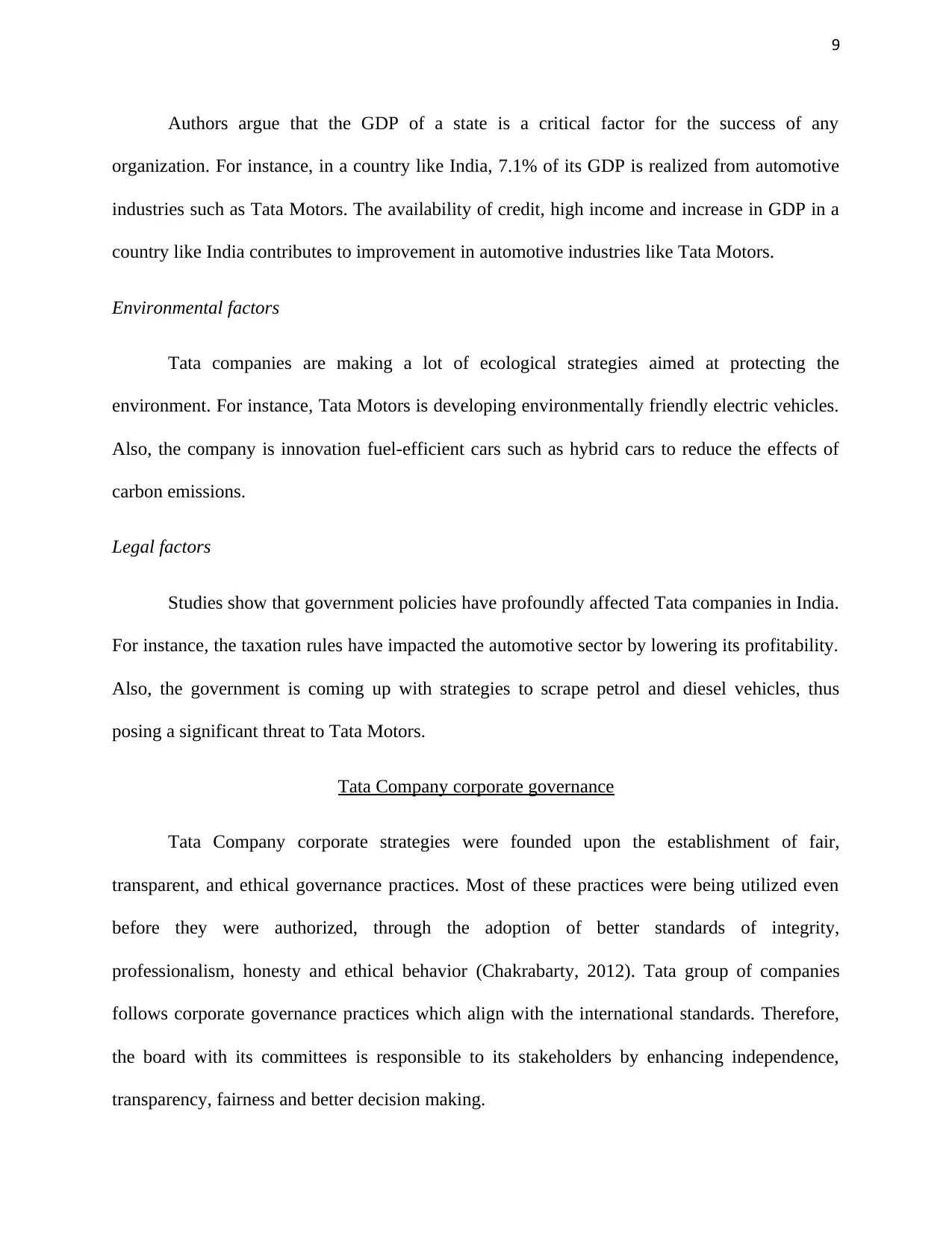
9
Authors argue that the GDP of a state is a critical factor for the success of any
organization. For instance, in a country like India, 7.1% of its GDP is realized from automotive
industries such as Tata Motors. The availability of credit, high income and increase in GDP in a
country like India contributes to improvement in automotive industries like Tata Motors.
Environmental factors
Tata companies are making a lot of ecological strategies aimed at protecting the
environment. For instance, Tata Motors is developing environmentally friendly electric vehicles.
Also, the company is innovation fuel-efficient cars such as hybrid cars to reduce the effects of
carbon emissions.
Legal factors
Studies show that government policies have profoundly affected Tata companies in India.
For instance, the taxation rules have impacted the automotive sector by lowering its profitability.
Also, the government is coming up with strategies to scrape petrol and diesel vehicles, thus
posing a significant threat to Tata Motors.
Tata Company corporate governance
Tata Company corporate strategies were founded upon the establishment of fair,
transparent, and ethical governance practices. Most of these practices were being utilized even
before they were authorized, through the adoption of better standards of integrity,
professionalism, honesty and ethical behavior (Chakrabarty, 2012). Tata group of companies
follows corporate governance practices which align with the international standards. Therefore,
the board with its committees is responsible to its stakeholders by enhancing independence,
transparency, fairness and better decision making.
Authors argue that the GDP of a state is a critical factor for the success of any
organization. For instance, in a country like India, 7.1% of its GDP is realized from automotive
industries such as Tata Motors. The availability of credit, high income and increase in GDP in a
country like India contributes to improvement in automotive industries like Tata Motors.
Environmental factors
Tata companies are making a lot of ecological strategies aimed at protecting the
environment. For instance, Tata Motors is developing environmentally friendly electric vehicles.
Also, the company is innovation fuel-efficient cars such as hybrid cars to reduce the effects of
carbon emissions.
Legal factors
Studies show that government policies have profoundly affected Tata companies in India.
For instance, the taxation rules have impacted the automotive sector by lowering its profitability.
Also, the government is coming up with strategies to scrape petrol and diesel vehicles, thus
posing a significant threat to Tata Motors.
Tata Company corporate governance
Tata Company corporate strategies were founded upon the establishment of fair,
transparent, and ethical governance practices. Most of these practices were being utilized even
before they were authorized, through the adoption of better standards of integrity,
professionalism, honesty and ethical behavior (Chakrabarty, 2012). Tata group of companies
follows corporate governance practices which align with the international standards. Therefore,
the board with its committees is responsible to its stakeholders by enhancing independence,
transparency, fairness and better decision making.
⊘ This is a preview!⊘
Do you want full access?
Subscribe today to unlock all pages.

Trusted by 1+ million students worldwide
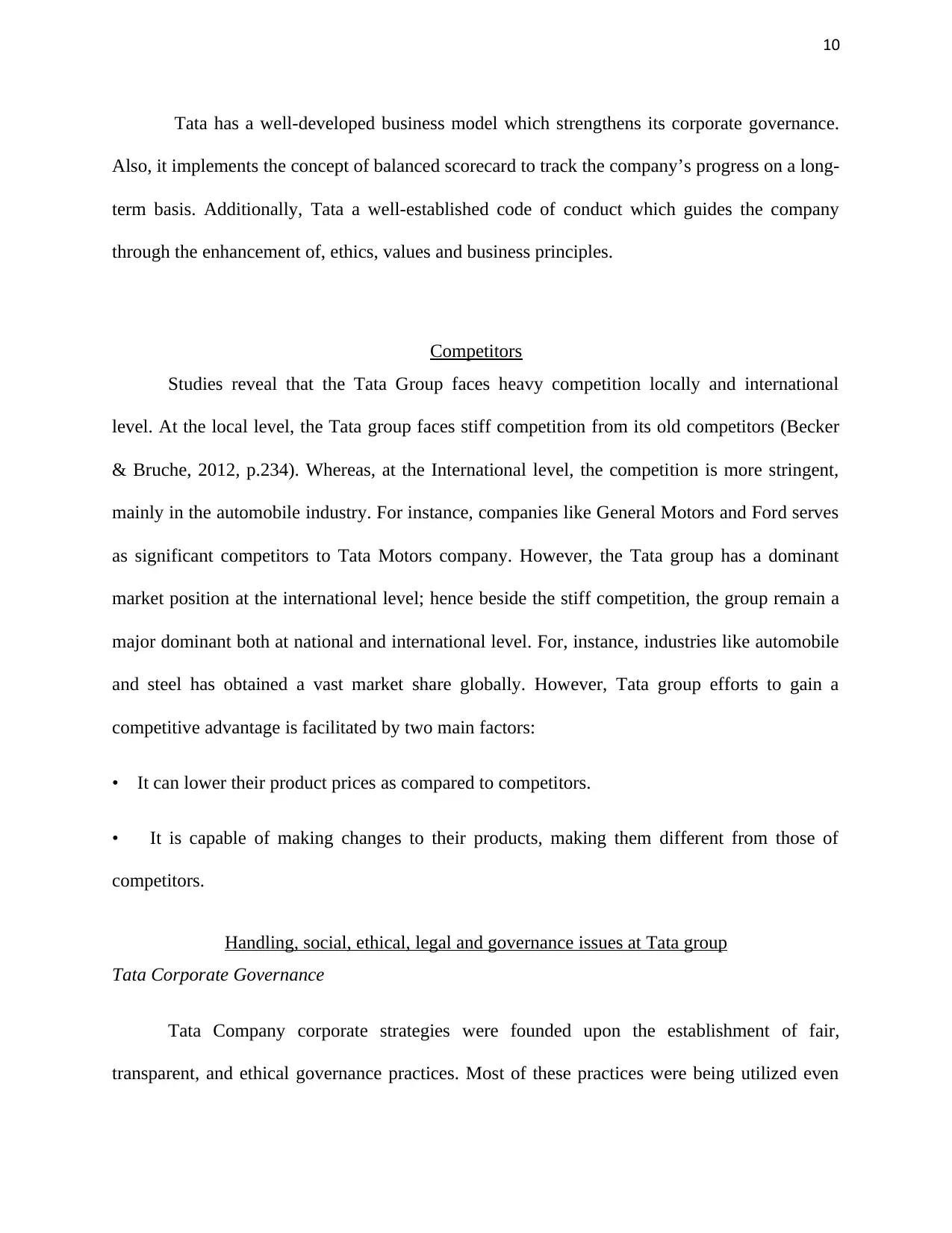
10
Tata has a well-developed business model which strengthens its corporate governance.
Also, it implements the concept of balanced scorecard to track the company’s progress on a long-
term basis. Additionally, Tata a well-established code of conduct which guides the company
through the enhancement of, ethics, values and business principles.
Competitors
Studies reveal that the Tata Group faces heavy competition locally and international
level. At the local level, the Tata group faces stiff competition from its old competitors (Becker
& Bruche, 2012, p.234). Whereas, at the International level, the competition is more stringent,
mainly in the automobile industry. For instance, companies like General Motors and Ford serves
as significant competitors to Tata Motors company. However, the Tata group has a dominant
market position at the international level; hence beside the stiff competition, the group remain a
major dominant both at national and international level. For, instance, industries like automobile
and steel has obtained a vast market share globally. However, Tata group efforts to gain a
competitive advantage is facilitated by two main factors:
• It can lower their product prices as compared to competitors.
• It is capable of making changes to their products, making them different from those of
competitors.
Handling, social, ethical, legal and governance issues at Tata group
Tata Corporate Governance
Tata Company corporate strategies were founded upon the establishment of fair,
transparent, and ethical governance practices. Most of these practices were being utilized even
Tata has a well-developed business model which strengthens its corporate governance.
Also, it implements the concept of balanced scorecard to track the company’s progress on a long-
term basis. Additionally, Tata a well-established code of conduct which guides the company
through the enhancement of, ethics, values and business principles.
Competitors
Studies reveal that the Tata Group faces heavy competition locally and international
level. At the local level, the Tata group faces stiff competition from its old competitors (Becker
& Bruche, 2012, p.234). Whereas, at the International level, the competition is more stringent,
mainly in the automobile industry. For instance, companies like General Motors and Ford serves
as significant competitors to Tata Motors company. However, the Tata group has a dominant
market position at the international level; hence beside the stiff competition, the group remain a
major dominant both at national and international level. For, instance, industries like automobile
and steel has obtained a vast market share globally. However, Tata group efforts to gain a
competitive advantage is facilitated by two main factors:
• It can lower their product prices as compared to competitors.
• It is capable of making changes to their products, making them different from those of
competitors.
Handling, social, ethical, legal and governance issues at Tata group
Tata Corporate Governance
Tata Company corporate strategies were founded upon the establishment of fair,
transparent, and ethical governance practices. Most of these practices were being utilized even
Paraphrase This Document
Need a fresh take? Get an instant paraphrase of this document with our AI Paraphraser
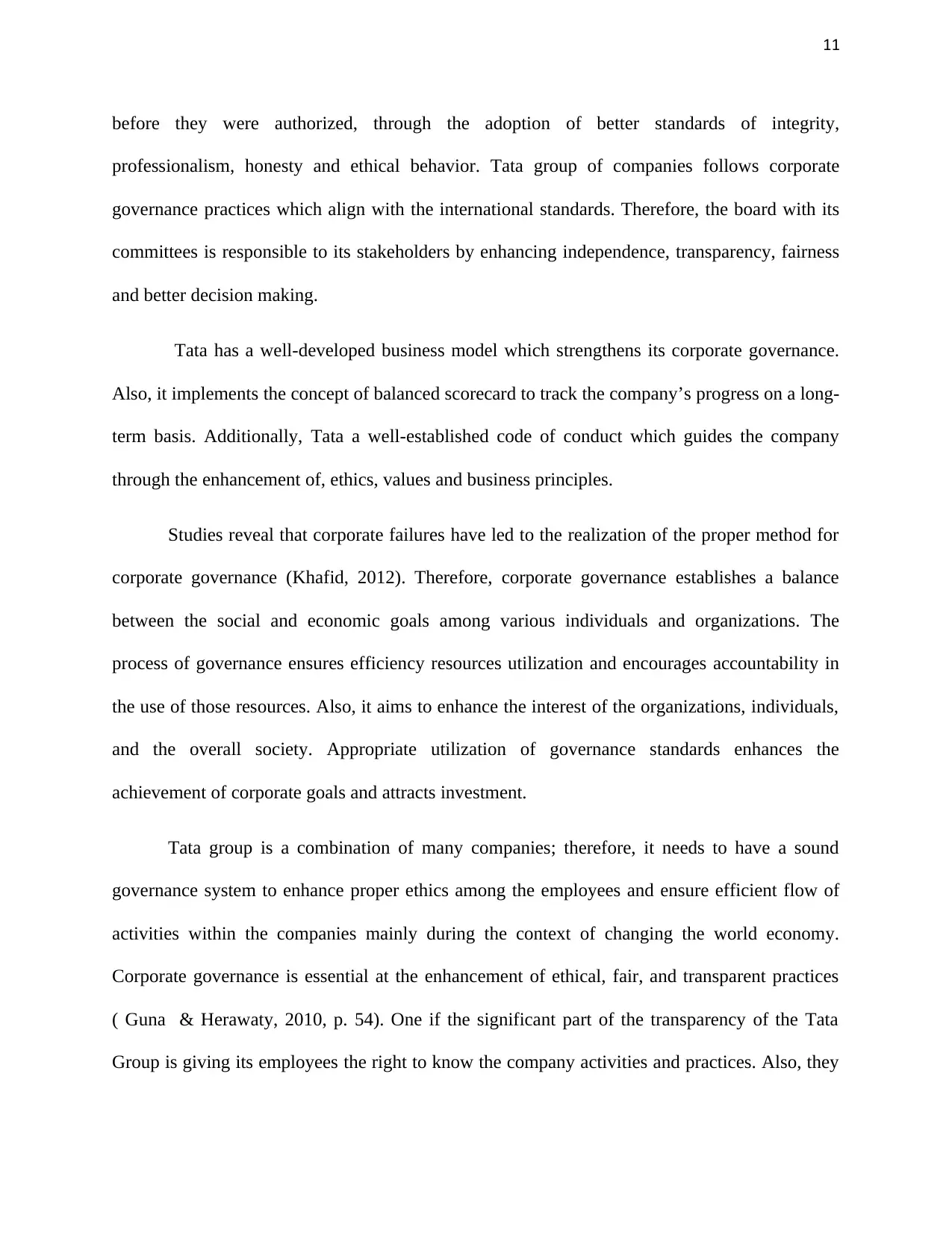
11
before they were authorized, through the adoption of better standards of integrity,
professionalism, honesty and ethical behavior. Tata group of companies follows corporate
governance practices which align with the international standards. Therefore, the board with its
committees is responsible to its stakeholders by enhancing independence, transparency, fairness
and better decision making.
Tata has a well-developed business model which strengthens its corporate governance.
Also, it implements the concept of balanced scorecard to track the company’s progress on a long-
term basis. Additionally, Tata a well-established code of conduct which guides the company
through the enhancement of, ethics, values and business principles.
Studies reveal that corporate failures have led to the realization of the proper method for
corporate governance (Khafid, 2012). Therefore, corporate governance establishes a balance
between the social and economic goals among various individuals and organizations. The
process of governance ensures efficiency resources utilization and encourages accountability in
the use of those resources. Also, it aims to enhance the interest of the organizations, individuals,
and the overall society. Appropriate utilization of governance standards enhances the
achievement of corporate goals and attracts investment.
Tata group is a combination of many companies; therefore, it needs to have a sound
governance system to enhance proper ethics among the employees and ensure efficient flow of
activities within the companies mainly during the context of changing the world economy.
Corporate governance is essential at the enhancement of ethical, fair, and transparent practices
( Guna & Herawaty, 2010, p. 54). One if the significant part of the transparency of the Tata
Group is giving its employees the right to know the company activities and practices. Also, they
before they were authorized, through the adoption of better standards of integrity,
professionalism, honesty and ethical behavior. Tata group of companies follows corporate
governance practices which align with the international standards. Therefore, the board with its
committees is responsible to its stakeholders by enhancing independence, transparency, fairness
and better decision making.
Tata has a well-developed business model which strengthens its corporate governance.
Also, it implements the concept of balanced scorecard to track the company’s progress on a long-
term basis. Additionally, Tata a well-established code of conduct which guides the company
through the enhancement of, ethics, values and business principles.
Studies reveal that corporate failures have led to the realization of the proper method for
corporate governance (Khafid, 2012). Therefore, corporate governance establishes a balance
between the social and economic goals among various individuals and organizations. The
process of governance ensures efficiency resources utilization and encourages accountability in
the use of those resources. Also, it aims to enhance the interest of the organizations, individuals,
and the overall society. Appropriate utilization of governance standards enhances the
achievement of corporate goals and attracts investment.
Tata group is a combination of many companies; therefore, it needs to have a sound
governance system to enhance proper ethics among the employees and ensure efficient flow of
activities within the companies mainly during the context of changing the world economy.
Corporate governance is essential at the enhancement of ethical, fair, and transparent practices
( Guna & Herawaty, 2010, p. 54). One if the significant part of the transparency of the Tata
Group is giving its employees the right to know the company activities and practices. Also, they
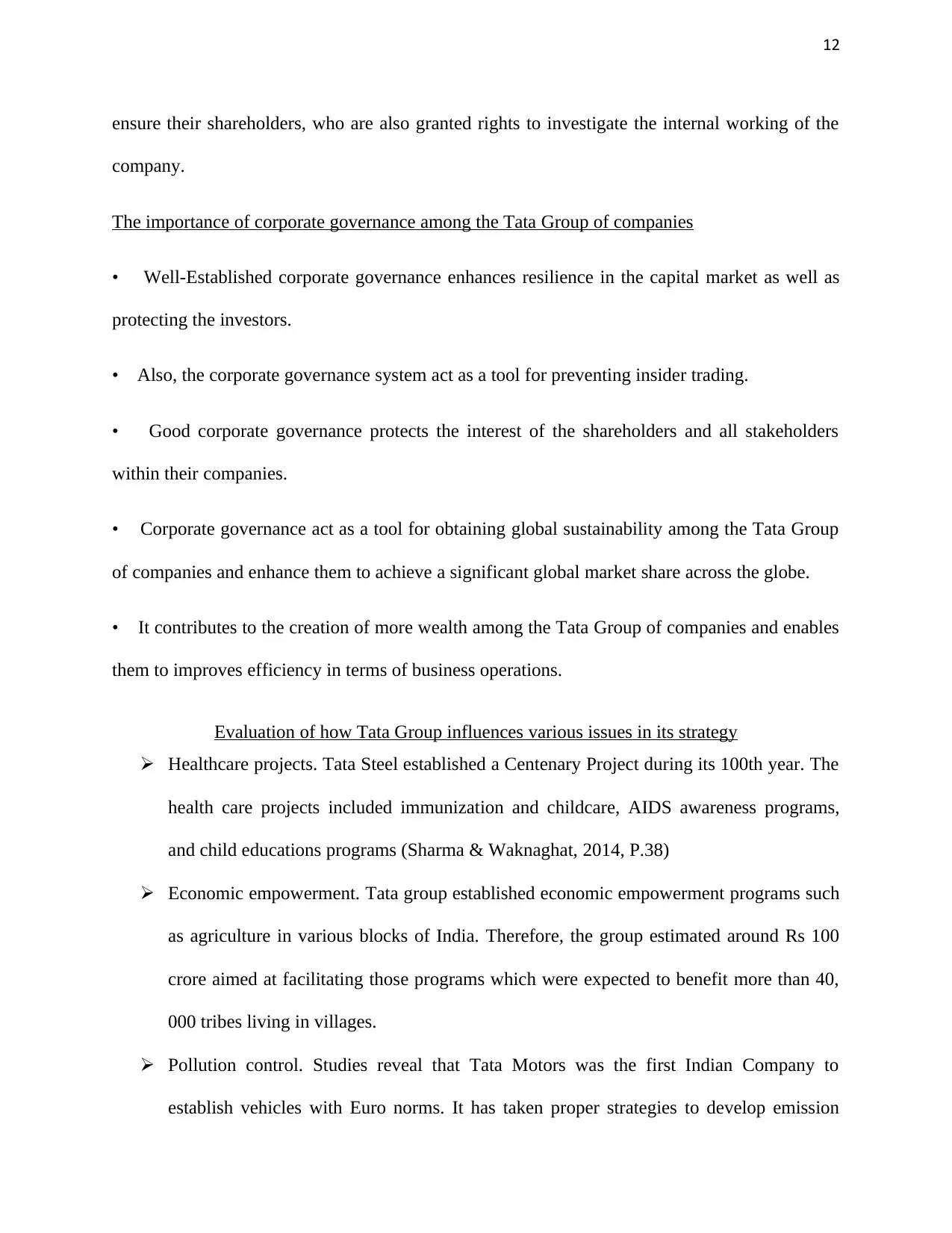
12
ensure their shareholders, who are also granted rights to investigate the internal working of the
company.
The importance of corporate governance among the Tata Group of companies
• Well-Established corporate governance enhances resilience in the capital market as well as
protecting the investors.
• Also, the corporate governance system act as a tool for preventing insider trading.
• Good corporate governance protects the interest of the shareholders and all stakeholders
within their companies.
• Corporate governance act as a tool for obtaining global sustainability among the Tata Group
of companies and enhance them to achieve a significant global market share across the globe.
• It contributes to the creation of more wealth among the Tata Group of companies and enables
them to improves efficiency in terms of business operations.
Evaluation of how Tata Group influences various issues in its strategy
Healthcare projects. Tata Steel established a Centenary Project during its 100th year. The
health care projects included immunization and childcare, AIDS awareness programs,
and child educations programs (Sharma & Waknaghat, 2014, P.38)
Economic empowerment. Tata group established economic empowerment programs such
as agriculture in various blocks of India. Therefore, the group estimated around Rs 100
crore aimed at facilitating those programs which were expected to benefit more than 40,
000 tribes living in villages.
Pollution control. Studies reveal that Tata Motors was the first Indian Company to
establish vehicles with Euro norms. It has taken proper strategies to develop emission
ensure their shareholders, who are also granted rights to investigate the internal working of the
company.
The importance of corporate governance among the Tata Group of companies
• Well-Established corporate governance enhances resilience in the capital market as well as
protecting the investors.
• Also, the corporate governance system act as a tool for preventing insider trading.
• Good corporate governance protects the interest of the shareholders and all stakeholders
within their companies.
• Corporate governance act as a tool for obtaining global sustainability among the Tata Group
of companies and enhance them to achieve a significant global market share across the globe.
• It contributes to the creation of more wealth among the Tata Group of companies and enables
them to improves efficiency in terms of business operations.
Evaluation of how Tata Group influences various issues in its strategy
Healthcare projects. Tata Steel established a Centenary Project during its 100th year. The
health care projects included immunization and childcare, AIDS awareness programs,
and child educations programs (Sharma & Waknaghat, 2014, P.38)
Economic empowerment. Tata group established economic empowerment programs such
as agriculture in various blocks of India. Therefore, the group estimated around Rs 100
crore aimed at facilitating those programs which were expected to benefit more than 40,
000 tribes living in villages.
Pollution control. Studies reveal that Tata Motors was the first Indian Company to
establish vehicles with Euro norms. It has taken proper strategies to develop emission
⊘ This is a preview!⊘
Do you want full access?
Subscribe today to unlock all pages.

Trusted by 1+ million students worldwide
1 out of 22
Your All-in-One AI-Powered Toolkit for Academic Success.
+13062052269
info@desklib.com
Available 24*7 on WhatsApp / Email
![[object Object]](/_next/static/media/star-bottom.7253800d.svg)
Unlock your academic potential
Copyright © 2020–2025 A2Z Services. All Rights Reserved. Developed and managed by ZUCOL.